Is Your Data a Security Risk?


Now here's a good article on the subject from Louella Fernandes, Principal Analyst with Quocirca. Titled, "Data Security: Key Steps to Shredding the Printer Threat," the article not only looks at some of the risks inherent in networked MFPs, but at some of the steps you can take to assure good security practices.
The cost of accidental or malicious data loss can be severe. As well as penalties from regulators and industry bodies, there is also damage to the brand, which can lead to lost business.
So many organizations have taken measures, ranging from encryption to data loss prevention, to cut the risks. But one area is often overlooked and it is perhaps the least secure medium of all: printed output. Although the widespread use of networked printers has brought speed and convenience, it has also introduced potential security risks. Print jobs routinely contain sensitive information and it is not unusual for pages to be left unclaimed in a printer tray, just waiting to fall into the wrong hands.
Multifunction peripherals But that issue is the tip of the iceberg. Today's advanced networked multifunction peripherals print, copy, scan to network destinations and send email attachments. These devices are far from peripheral to the network, posing the same security risks as any other networked device.
They are equipped with a hard drive that stores user IDs, as well as copy, scan, fax, and print images from previously processed jobs and device logs. Consequently, information can be leaked not only through printed documents, but also via unauthorized access to the device and its hard drive, and through the unauthorized distribution of confidential documents via scan-to-email.
Doc was not surprised that this article highlights a case where 400,000 healthcare customer records were compromised when an MFP was returned on lease before the hard drive was erased properly. The threat of MFP security problems is very real. Read more and find out what you can do to prevent any data losses.